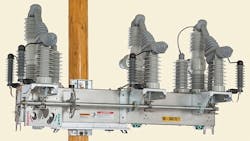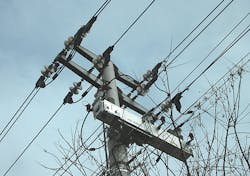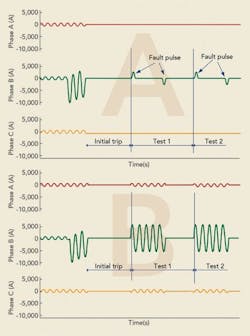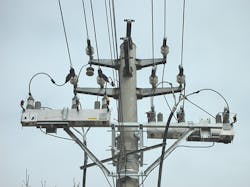To improve the reliability and resilience of distribution networks, many techniques can be employed: good design, vegetation management, protection coordination and control philosophy. Beyond these standard practices, the most significant step toward improving network reliability and resilience comes from the use of distribution automation that focuses on network feeders. Now more commonly known as a self-healing system, this form of distribution automation enables switching devices to be installed on the worst-performing network feeders.
Significant reliability improvement is one of the key drivers of distribution automation, as utilities strive to reduce the now commonly used system average interruption duration index (SAIDI). In deregulated distribution utilities in particular, network operators are required to demonstrate — through a cost-benefit analysis — investment in feeder automation is the most efficient way to improve the reliability of supply.
A utility owned by the Chinese central government, the State Grid Corp. of China (SGCC), serves more than 128 million people. SGCC sought to improve network reliability and resilience across its service area. The 10-kV Ningxia network in Wuzhong Province was selected for a pilot project to demonstrate the performance of S&C Electric’s self-healing solution feeder solution featuring distributed intelligence. This network was selected for its configuration and the common severe weather conditions in the area, which would test the performance of the self-healing equipment. With the pilot project, the utility aims to benchmark the effectiveness of this overhead line equipment and determine whether further expansion would be beneficial throughout its service territory.
Network Selection
The self-healing equipment has been implemented on four feeders at two substations, Beijiao and Wuzhong. Three feeders combine underground cables and overhead lines, and one feeder is an overhead line. The four feeders serve various loads, including schools, office buildings and approximately 300 retail shops.
The pilot project is designed to test the performance of the self-healing system as well as to demonstrate the technological advantages of pulse-closing technology. The pulse-closing fault interrupters detect faults on the network and use the technology to test and determine whether a fault is temporary or permanent. If temporary, the devices restore power in seconds without damaging equipment with fault currents. If the fault is permanent, the devices use the intelligence in the automatic restoration system software to isolate the faulted section of the network and reroute the power supply from other available feeders within a few seconds.
This self-healing system enables the utility to fix the worst-performing feeders, providing immediate results visible to the customer at an acceptable cost. The proposed self-healing system is designed and prepared for future expansion without the need for a complete revamp or redesign of the network. Properly executed, it supports and enhances the existing infrastructure such as the supervisory control and data acquisition (SCADA) system, rather than supplanting it. The switching device locations on the 10-kV network were selected for automation based on the cost justified by reliability improvement studies and calculations.
The project comprises seven pulse-closing fault interrupters, each equipped with IntelliTeam SG automatic restoration system software. The interrupters communicate with each other and the utility’s SCADA system using Siemens’ Ruggedcom RS900 fiber-optic transceivers. Designer software is used to configure the teams and retrieve operational data.
System Configuration
The IntelliRupter is a pole-mounted vacuum interrupter with unique features designed to accommodate advanced distribution automation functions, including self-healing. The interrupter has the following features:
•Unique pulse-closing technology confirms there is no fault on the line before initiating point-on-wave closing.
•Vacuum interrupters with a unique actuating system enables pulse-closing technology.
•Integrated three-phase voltage occurs on both sides of the interrupters.
•Integrated three-phase current sensing provides linear output over the range from load to fault current.
•There’s an integrated power module on both sides of the interrupters; the inclusion of a second integral power module enables powering of an open interrupter when either side of the unit is energized.
•Integrated control and communications modules protect the electronics from vandalism, inclement weather and electrical surges. Wi-Fi connectivity from work vehicles enhances worker safety and comfort. The communications module also contains the backup batteries and a control module, which is contained within the unitized stainless-steel base of the fault interrupter.
Each self-contained interrupter is designed for simple installation on pole-mounted applications. It has multiple protection profiles, making it possible to switch quickly between applications, and offers bidirectional load measurement and coordination. The protection and control module provides point-on-wave closing to minimize asymmetric fault current and inrush current.
It features a complete set of protection and control functions, including simultaneous independent directional phase, ground and negative-sequence instantaneous and time-overcurrent elements; simultaneous independent directional phase, ground and negative-sequence definite-time elements; intelligent fuse-saving overcurrent elements; overvoltage and undervoltage elements, over- and under-frequency elements, sync-check and sensitive earth fault protection.
Conventional autoreclosers trip to clear a fault, then reclose to determine whether the fault has disappeared or still remains. Each reclose attempt subjects the full fault current, thus stressing the network equipment until a tripping and lockout condition is reached. Additionally, voltage sags are experienced by all upstream loads, including adjacent healthy feeders fed from the same substation busbar, because the reclosing is random relative to the voltage point-on-wave closing.
Unlike these conventional autoreclosers, the intelligent interrupters’ pulse-closing technology injects, after the fault interruption, a low-energy current pulse into the overhead line to determine whether the fault is cleared. The low-energy current is analyzed immediately, and a load or fault condition is declared within a few cycles. The technology has the ability to close the fault interrupters’ contacts at a specified point on the voltage wave that generates sufficient current to measure and analyze the fault condition while minimizing the let-through energy into the fault.
Intelligent Node Interface
The S&C IntelliNode is a universal interface module that enables a substation circuit breaker and other electronic devices to operate as part of the IntelliTeam SG automatic restoration system, helping to minimize the impact of a further outage. It enables the host device to communicate with other equipment and implement smart grid restoration decisions.
Fault-interrupting and protective functions remain under control of the host intelligent electronic device. The intelligent node is connected to the protective relay or the recloser control through a serial or Ethernet cable that supports distributed network protocol (DNP) 3.0 for communication with a SCADA master or substation remote terminal unit. All configurable DNP points are normally scanned by the SCADA master as well as all IntelliTeam DNP points.
Automatic Restoration System
IntelliTeam SG is a field-proven universal smart grid solution that automatically reconfigures the distribution system after a fault and quickly restores service to those sections of the feeder not affected by the fault. Although fully compatible with SCADA, no SCADA control or central monitoring is required as decisions are made locally, based on real-time loading data.
IntelliTeam SG supports complex systems of virtually any size, accommodates tie points from multiple sources and can handle as many teams of intelligent interrupters as the line loading will allow. Team and coach metaphors are used to describe the IntelliTeam SG software operation. Each team is a line segment bound by up to eight switches, each of which can represent a different power source. The software coach continually monitors the real-time voltage and current of each team member and shares this information with the coaches of adjacent teams. Each interrupter is configured to know its normal role in the system, its name (DNP address), and other key settings such as the maximum load capacity, allocated function within the team or power source priority.
Using the voltages and currents measured at the interrupter, along with the configuration settings, the IntelliTeam SG will identify the location of a fault anywhere in the system. When an outage or line fault occurs, the coach of each affected team uses the real-time data, plus voltage and current prior to the system event, to develop a restoration strategy. The coaches work together to implement ways to maximize restoration within the defined prioritization rules. The intelligent automatic restoration system operating principles are simple:
•Each team’s mission is to maintain power on its line segment, using the normal power source whenever possible.
•Each team communicates with neighboring teams through switch controls they share in common. The excess capacity of a neighboring team is a possible restoration source available at the shared switch.
•Each switch control monitors the current and voltage at its switches. If a fault occurs, the coach of the faulted team recognizes the fault is located within its team because fault current was sensed at only one team switch. (Unfaulted teams upstream of the faulted team will have sensed fault current at multiple switches, indicating the fault current traveled through the team.) The coach of the faulted team opens all team switches and prevents them from closing, isolating the fault.
• If an unfaulted team experiences extended loss of voltage, its coach evaluates the excess capacity of neighboring teams and transfers load to the first team with sufficient capacity. The alternative source can be more than one team away; inter-team data exchange ensures the sharing of excess capacity and coordination of restoration decisions. If desired, the order in which alternate sources are specified can be prioritized.
•When normal power has been restored or the fault has been corrected, the system returns to its normal configuration, either manually, automatically or through SCADA control. Restoration is typically completed in seconds.
Pulse-Finding Technique
A related concept is fault hunting. When two or more devices trip for a given event, or when the substation circuit breaker overreaches and trips for faults that midline devices should have cleared, crews may resort to closing one device at a time to determine if the downstream section is faulted, based on whether the autorecloser stays closed or trips open. If the auto-recloser holds, the crew moves to the next downstream device until the fault is found. Finding the fault location by closing autoreclosers or circuit breakers always results in putting the fault on the system again.
Pulse-closing devices can be operated in a similar fashion, except locating the fault only involves a pulse of fault current on the line, not a fault of full magnitude and duration. If an overcurrent situation is predicted by the pulse-closing algorithm, the device remains open. Coordinating many devices in series in high fault-current areas becomes challenging, especially when sensing and timing tolerances are taken into account. The standard time-current coordination practices between series-connected interrupters can be ignored. The protection settings in any number of series interrupters is implemented by keeping the same settings or making them marginally faster than their next upstream interrupter. This technique is called pulse finding.
Positive Outcome
After the installation and commissioning of interrupters, but before site automation testing was completed by the manufacturer’s staff, power transmission was lost at substation 2 on the 10-kV overhead line in Ningxia. The interrupters installed on both 10-kV feeders immediately responded to the loss of voltage event and restored supply to the loads normally served by substation 2. Interrupter units IR 3 and IR 7 experienced an extended loss of voltage and tripped open, and interrupter units IR 2 and IR 6 closed, restoring service to their associated line sections, using power from substation 1.
SGCC engineers were anxious to retrieve the data associated with the event, as the SCADA connection to the interrupters was not functional. Using a computer with access to the fiber-optic network, the engineers ran the IntelliTeam Designer to poll the affected devices and compile an event summary. The engineers were impressed it took only a few minutes to gather data from the interrupters and demonstrate the event.
The pilot program has been deemed successful based on the reliability performance improvement measured and costs being lower than expected. SGCC will continue to monitor the performance of these fault interruption systems to improve the benefit versus cost analysis over a longer operating period.
Acknowledgement
The author wishes to thank Serge Kabunda and Bo Chen of S&C Electric Co. for their technical assistance and support given in the preparation of this article.
Sihui Yue is acting deputy director of Wuzhong Power Supply Co.’s operation and maintenance department. Yue graduated from Beijing Electrical Power College of Higher Education with a master’s degree in power system and telecommunication engineering and then joined the Wuzhong Power Supply Co. He has broad experience in power distribution system development and operation. For the past 20 years, Yue has been involved in various power engineering projects that include power system and telecommunication maintenance, power distribution automation and management, and the design and upgrade of the power distribution system in cities and rural areas.





